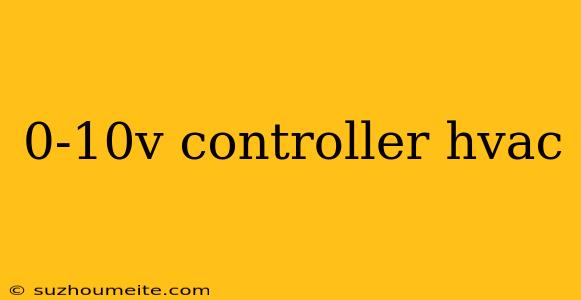0-10V Controller for HVAC Systems: A Comprehensive Guide
In heating, ventilation, and air conditioning (HVAC) systems, controlling temperature, humidity, and airflow is crucial to maintain a comfortable indoor environment. One of the most common control methods used in HVAC systems is the 0-10V controller. In this article, we will delve into the world of 0-10V controllers, exploring their working principle, advantages, and applications in HVAC systems.
What is a 0-10V Controller?
A 0-10V controller is an electronic device that regulates the speed of HVAC equipment, such as fans, pumps, and compressors, by varying the voltage supplied to them. The controller outputs a 0-10V direct current (DC) signal, which is proportional to the desired speed or output of the equipment. The 0-10V signal is then used to control the equipment's speed through a variable frequency drive (VFD) or a motor controller.
Working Principle of a 0-10V Controller
The working principle of a 0-10V controller is based on the concept of pulse-width modulation (PWM). The controller receives input signals from sensors, such as temperature, pressure, or flow sensors, and uses these signals to determine the desired speed or output of the equipment. The controller then generates a PWM signal, which is a series of high-frequency pulses with varying widths, to control the equipment's speed.
The PWM signal is converted into a 0-10V DC signal, which is then sent to the VFD or motor controller. The VFD or motor controller receives the 0-10V signal and adjusts the frequency of the AC power supply to the equipment, thus controlling its speed.
Advantages of 0-10V Controllers
0-10V controllers offer several advantages in HVAC systems, including:
Energy Efficiency
0-10V controllers can optimize energy consumption by reducing the speed of equipment during periods of low demand, resulting in significant energy savings.
Improved Control
0-10V controllers provide precise control over equipment speed, allowing for accurate temperature, humidity, and airflow control.
Flexibility
0-10V controllers can be used to control a wide range of HVAC equipment, including fans, pumps, compressors, and valves.
Reliability
0-10V controllers are highly reliable and can operate in harsh environments, making them ideal for HVAC applications.
Applications of 0-10V Controllers in HVAC Systems
0-10V controllers are widely used in various HVAC applications, including:
Air Handling Units (AHUs)
0-10V controllers are used to control the speed of fans, coils, and other equipment in AHUs to maintain comfortable indoor air quality.
Chillers and Heat Pumps
0-10V controllers are used to control the speed of compressors, pumps, and fans in chillers and heat pumps to optimize energy efficiency and performance.
Variable Air Volume (VAV) Systems
0-10V controllers are used to control the speed of fans and dampers in VAV systems to optimize airflow and energy efficiency.
Conclusion
In conclusion, 0-10V controllers play a vital role in HVAC systems, offering precise control, energy efficiency, and flexibility. By understanding the working principle, advantages, and applications of 0-10V controllers, HVAC engineers and technicians can design and implement efficient and effective HVAC systems that provide comfortable indoor environments while minimizing energy consumption.
